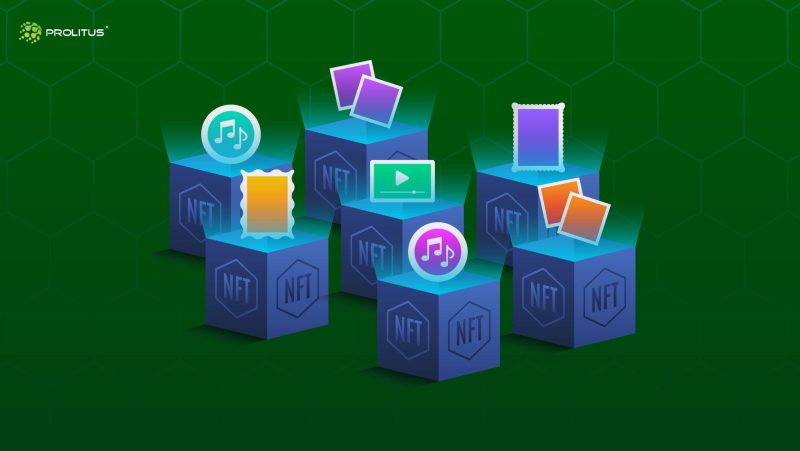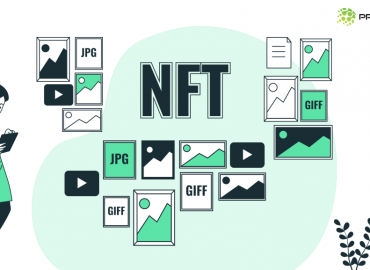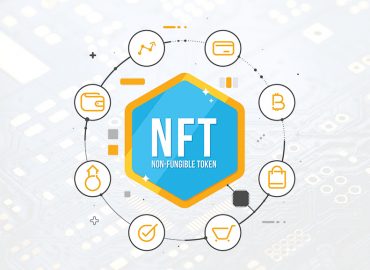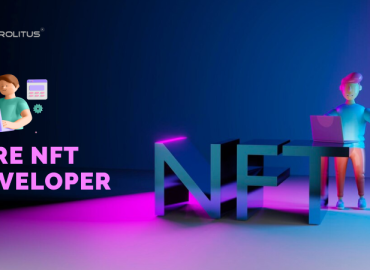In recent years, the music industry has undergone many significant changes. For example, people can now pay a set amount each month for access to a limitless music catalog, thanks to the development of streaming services such as Spotify and Apple Music. As a direct result, there has been a significant shift in how artists earn their living. In addition, the proliferation of blockchain technology and digital assets has given creatives a fresh opportunity to generate revenue from their work: non-fungible tokens (NFTs).
Because NFTs are one-of-a-kind and cannot be duplicated, they are ideally suited for storing works of art, films, and musical compositions. When an artist publishes their work as an NFT, they have the option of determining the price at which it will be offered for sale. If someone purchases the NFT, they will own it permanently and have complete discretion over how they put it to use.
Artists utilize blockchain technology by creating a non-fungible token (NFT) of a piece of music and then selling it on a marketplace based on blockchain technology. As a result of this development, people will now have the capacity to own the song permanently and listen to it anytime they like.
Depending on what you want to accomplish as an artist, there are several different reasons why you would like to combine NFTs and music.
Artists can demonstrate their gratitude for the support of their followers by providing them with unique access to digital materials. In addition, artists now have a new option to monetize their work; musicians may make money directly from their fans by selling NFTs of their songs or live events.
NFTs offer artists the opportunity to monetize their work. Last but not least, the fact that NFTs and music are both highly well-liked types of entertainment makes for a natural and wonderful mix. If you combine the two, you can expand your brand and communicate with a more significant number of individuals.
What are NFTs?
Non-Fungible Tokens (NFTs) are a new type of digital asset on the blockchain that allows for unique items to be traded and stored without a central authority. They are similar to tokens, but NFTs are not just used for transactions or rewards—they can also represent ownership of assets, such as virtual goods or shares in a company. This opens up exciting possibilities for businesses and individuals who want to use blockchain technology to create more secure and transparent systems.
Nick Szabo first proposed NFTs in 2010, and they have been gaining popularity recently due to their potential applications in the cryptocurrency market. Cryptocurrency is decentralized, meaning that there is no central authority that can control it. This makes it difficult to track transactions and validate the legitimacy of coins, which is why many experts believe that cryptocurrencies will eventually become mainstream payment methods.
What are music NFTs, and how are they shaping the way music sounds?
What are music NFTs? In a nutshell, they’re digital files representing an exclusive right to an artist’s music access and listening to music. Music NFTs can be used in various ways, such as tickets to concerts or acquire music. They’ve been around for some time but are still relatively new.
Music nfts offer artists a way to generate income that wasn’t possible before. Previously, artists relied on traditional methods such as touring and album sales in order to generate revenue. However, with music nfts, they can instead focus on creating more content and generating more revenue from their platforms.
NFT technology is complex, but it offers excellent potential for artists and fans alike. The first musical NFT was created in 2015 by artist and drummer Mike Portnoy. Since then, over 100 music NFTs have been created, including works by artists like Radiohead and David Bowie. The popularity of music NFTs is partly due to their ability to create more customized experiences for fans.
With music NFTs, musicians can sell their music directly to fans without needing a third party like iTunes or Spotify.
Music, NFT Marketplaces
Even though the largest NFT marketplace, OpenSea, has a dedicated archive for music NFTs, most artists choose to debut their projects on music-specific platforms instead.
In the world of non-fungible tokens (NFTs), the category of single-edition music NFTs is referred to as 1/1. The Catalog is the principal marketplace for these NFTs. It is constructed on the Zora protocol, which also serves as the foundation for the Zora marketplace, a competitor to OpenSea’s Zora marketplace. As of February 2021, musicians have generated revenue on “Catalog,” totaling $2 million, through the sale of music NFTs.
Some musicians would instead release limited editions, such as 10 NFTs attached to a single track, rather than 1/1 copies of their work. sound.xyz is a well-liked choice because it offers virtually daily drops at which collectors and traders can purchase mint versions of music that are not for sale. In addition, these newly produced NFTs are eligible for immediate resale on secondary markets such as OpenSea or Raible.
Foundation, Arpeggi, and FormFunction are a few examples of platforms other than FormFunction that allow artists to mint 1/1s.
Different kinds of musical expressions are highlighted on various platforms. For example, Groovetime is a platform specializing in distributing dance music NFTs, and HEAT is another platform that has not yet been released. Generative music is a type of music that is created through interactions between humans and machines. Beat Foundry makes it possible to mint generative music.
Music NFT DAOs
Decentralized autonomous organizations, sometimes called DAOs, are analogous to cryptocurrency-based investment cooperatives.
Some DAOs provide financial assistance to NFT artists. Membership in MusicFund is obtained through the purchase of NFTs, and holders have the opportunity to vote once every month on which three musicians will receive donations of ETH from the community fund. The first, second, and third-place artists each receive 0.6 ETH, 0.25 ETH, and 0.15 ETH, respectively. In addition, the artists get financial support and public acknowledgment for their work. After winning a grant in the second round of MusicFund’s competition, the band Bel released songs on the label Catalog. (Audius, which manages Audio Grants, is another music grant-maker in the cryptocurrency space; however, it is not a decentralized autonomous organization.)
Various other DAOs are focused on investing. For example, noise DAO was established with 65 founding members, who have collectively contributed 1,720 ETH toward the organization’s goal of fostering the development of NFT artists and investing in music-related NFTs.
In addition to financial investments, others like to keep things light-hearted—Friends with Benefits hosted a party in June 2021 at NFT.NYC was attended by many people and featured DJ sets by Caroline Polachek, Doss, Pussy Riot, and Channel Tres, amongst others.
Royalties
In most cases, non-fungible tokens for music can only be used to verify on-chain ownership of a token that is linked to a music file. They do not grant any additional rights beyond that, including, most significantly, the right to royalties.
There are, however, platforms that are working to change that.
Royal assists artists in minting royalty-bearing non-fungible tokens (NFTs), which they refer to as Limited Digital Assets, or LDAs. Fans who possess NFTs can more easily share in the profits generated by streaming royalties thanks to the facilitation provided by LDAs. In October of 2021, 3LAU was the first user to coin an LDA for the platform, and he did so for the music “Worst Case” and the artwork linked with it. Holders of NFTs are entitled to a 50% share of the streaming royalty rights.
Another platform working toward the goal of incorporating royalties into music NFTs is called Opulent. An agreement created with the artist enables token holders to maintain a portion of the music copyright for themselves.
Additionally, the platform has cutting-edge features: Loans backed by the artist’s future income can be obtained through the Defi platform if the artist chooses. Even if the dangers associated with Defi investments are still present, investors can “stake” crypto assets in order to supply money and obtain substantial returns.
Music and NFT videos
The number of music video NFT projects is relatively low, which may be since it is a more capital-intensive endeavor than other components of music NFTs.
One notable exception is Glass.XYZ. The nascent platform enables content producers to monetize videos as NFTs and publish them to the site. However, uploads are subject to the judgments made by the Glass.XYZ community.
If they are effective, music NFT videos may replace the advertising-supported model of Web 2 that is dependent on the number of views. It’s that hypothesis of the 1,000 most devoted fans all over again.
What does the future look like for Music NFTs?
Given the growing trend among musicians for NFTs, there seems to be a lot of potentials for NFTs and music to coexist easily in the coming future.
There is a possibility that more musicians will use NFTs to thank their followers. This would improve fan engagement by creating a more vital link between artists and fans and a stronger connection between them.
Second, there may be an increase in the number of services that let users create and sell NFTs without needing any prior experience with programming. People’s ability to participate in music and NFTs would be facilitated due to this change. Last but not least, the proliferation of platforms that enable the creation of smart contracts for selling NFTs is possible.
Musicians are gradually beginning to recognize the potential benefits of merging music and NFTs. As more and more artists pursue success in their careers, non-fungible tokens (NFTs) are emerging as an innovative approach to exploit the possibilities presented by the expanding blockchain technology.
Prolitus for Music NFT development
The use of NFTs appears to be increasing in modern times. Whether trading cards, postcards, or digital artworks, serious collectors will go to great lengths to acquire them all. Taking this into account, it’s a great idea to create an NFT marketplace or introduce an NFT app, as both solutions directly address the problems the intended users face.
There are various advantages to using NFT-based marketplaces. You need to be aware of both the optimal operation of your platform and the needs of diverse collector demographics. The question is, how much are they willing to spend to acquire what they want? Each product featured on your NFT platform should be evaluated for its potential value.
If you’re looking to put money into the blockchain sector’s growth, you have many excellent possibilities. However, instead of trying to figure things out on your own, it may be a good idea to seek the assistance of NFT developers who have experience in the sector.
We hope that consulting Prolitus and using our services will be an excellent jumping-off point for your next project. Get in touch with us or schedule a no-cost initial meeting, and we will begin working on your projects immediately.





